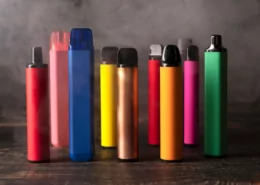Does Vaping Produce Smoke or Vapor? Understanding the Difference
If you’re new to the world of vaping, you might be wondering if it produces smoke like traditional cigarettes. The short answer is no; vaping doesn’t create smoke but rather an aerosol, commonly referred to as vapor. While the vapor might look similar to smoke, its composition and potential health effects are quite different.
What Is Vaping?
Vaping involves using an electronic device, often called an e-cigarette or vape pen, to heat a liquid (e-juice or vape juice) until it turns into an inhalable vapor. This liquid typically contains a mix of propylene glycol, vegetable glycerin, flavorings, and sometimes nicotine. Unlike smoking, which burns tobacco and creates harmful smoke, vaping heats the liquid without combustion.
Also read: The meaning of vaping explained
Components of a Vape
To better understand how vaping works, let’s take a look at the main components of a vape device:
- Battery: The power source that heats the liquid
- Tank: Holds the e-juice
- Coil: A heating element that vaporizes the liquid
- Wick: Absorbs the e-juice and delivers it to the coil
- Atomizer: Contains the coil and wick
- Mouthpiece: Where you inhale the vapor
Smoke vs. Vapor: What’s the Difference?
While smoke and vapor might look similar, they’re quite different in terms of their composition and how they’re created.
Smoke
Smoke is the result of combustion, which occurs when a substance (like tobacco) is burned. Cigarette smoke contains thousands of chemicals, many of which are toxic and can cause serious health problems. These include tar, carbon monoxide, and various carcinogens.
Vapor
Vapor, on the other hand, is created when a liquid is heated to the point of vaporization. While e-cigarette vapor does contain some chemicals, it typically has fewer harmful substances compared to cigarette smoke. However, it’s important to note that vaping is not entirely risk-free.

Health Implications of Vaping
Although vaping is often touted as a safer alternative to smoking, it still poses potential health risks.
Effects on Lungs
Inhaling vape aerosol can irritate the lungs and cause inflammation. According to Johns Hopkins Medicine, vaping may lead to lung damage, including lung inflammation and fluid buildup. The National Institutes of Health also warns that vaping exposes the lungs to various chemicals, such as nicotine and flavorings, which can be harmful.
Effects on Oral Health
While vaping doesn’t produce the tar and chemicals that cause teeth yellowing and gum disease like smoking does, it can still negatively impact oral health. Vape liquids may contain chemicals that can damage teeth and gums, and the heat from vaping can cause dry mouth, leading to bad breath and other issues.

Ecigator Sticky Open Pod Kit
The Sticky Open Pod Kit is a contemporary vaping device that combines functionality with fashion. This kit is designed with a box-style form factor, offering a compact and stylish appearance that’s ideal for vaping enthusiasts on the move.
At the heart of this kit is a Refillable Open Pod System, with a capacity of 2ml, perfect for accommodating a variety of e-liquids. The pod is equipped with a high-quality Mesh Coil that not only ensures a rich and flavorful vaping experience but also boasts durability for up to 8 Refills.
Environmental Impact of Vaping
Vaping not only affects personal health but also has environmental consequences.
Indoor Air Quality
Studies have shown that vaping can contribute to indoor air pollution. Compounds produced by vaping, such as formaldehyde, acrolein, and acetaldehyde, can linger in the air and impact overall air quality.
Outdoor Pollution
Vape waste, including plastic components, nicotine salts, heavy metals, and batteries, can pollute waterways, soil, and wildlife. Unlike cigarette butts, e-cigarette waste doesn’t biodegrade easily. Additionally, the production of vapes requires resource-intensive processes and materials, contributing to pollution and environmental damage.
Legal and Social Considerations
Vaping Laws
Vaping regulations vary widely by country and even by state or region. In the United States, for example, the FDA has the authority to regulate e-cigarettes and has banned all flavors except tobacco and menthol in cartridge-based e-cigarettes. It’s crucial for vapers to stay informed about local laws and regulations.
Social Perception
Society’s view of vaping is mixed. Some see it as a safer smoking alternative, while others consider it a harmful habit. This mixed perception stems partly from the lack of long-term research on vaping’s health effects. Vapers should be mindful of how their habits may be perceived by others and respect those around them.
Conclusion
While vaping produces vapor, not smoke, it’s not entirely harmless. Vape aerosol can contain harmful chemicals and may pose health risks, particularly to the lungs and oral health. Additionally, vaping has environmental consequences, both indoors and outdoors. As vaping regulations continue to evolve, it’s important for vapers to stay informed and considerate of those around them.
- HHC Vapes: What Are They & Are They Safe? - July 31, 2025
- Cannabis and Vape Shop Workers Rank Happiest in Nation - July 31, 2025
- Richmond, VA, Restricts New Vape & Tobacco Shop Locations - July 31, 2025








